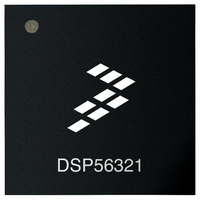DSP56321VF220 Freescale Semiconductor, DSP56321VF220 Datasheet - Page 20

DSP56321VF220
Manufacturer Part Number
DSP56321VF220
Description
IC DSP 24BIT 220MHZ 196-BGA
Manufacturer
Freescale Semiconductor
Series
DSP563xxr
Type
Fixed Pointr
Datasheet
1.DSP56321VL200R2.pdf
(84 pages)
Specifications of DSP56321VF220
Interface
Host Interface, SSI, SCI
Clock Rate
220MHz
Non-volatile Memory
ROM (576 B)
On-chip Ram
576kB
Voltage - I/o
3.30V
Voltage - Core
1.60V
Operating Temperature
-40°C ~ 100°C
Mounting Type
*
Package / Case
196-MAPBGA
Device Core Size
24b
Format
Fixed Point
Clock Freq (max)
220MHz
Mips
220
Device Input Clock Speed
220MHz
Ram Size
576KB
Operating Supply Voltage (typ)
1.6/3.3V
Operating Supply Voltage (min)
1.5/3/3/3/3/3/3V
Operating Temp Range
-40C to 100C
Operating Temperature Classification
Industrial
Mounting
Surface Mount
Pin Count
196
Package Type
MA-BGA
Package
196MA-BGA
Numeric And Arithmetic Format
Fixed-Point
Maximum Speed
220 MHz
Device Million Instructions Per Second
220 MIPS
Lead Free Status / RoHS Status
Contains lead / RoHS non-compliant
Available stocks
Company
Part Number
Manufacturer
Quantity
Price
Company:
Part Number:
DSP56321VF220
Manufacturer:
XILINX
Quantity:
615
Company:
Part Number:
DSP56321VF220
Manufacturer:
Freescale Semiconductor
Quantity:
10 000
Signals/Connections
1.11 JTAG and OnCE Interface
The DSP56300 family and in particular the DSP56321 support circuit-board test strategies based on the IEEE®
Std. 1149.1™ test access port and boundary scan architecture, the industry standard developed under the
sponsorship of the Test Technology Committee of IEEE and the JTAG. The OnCE module provides a means to
interface nonintrusively with the DSP56300 core and its peripherals so that you can examine registers, memory, or
on-chip peripherals. Functions of the OnCE module are provided through the JTAG TAP signals. For programming
models, see the chapter on debugging support in the DSP56300 Family Manual.
1-14
TCK
TDI
TDO
TMS
TRST
DE
Signal
Name
Input/ Output
Output
Type
Input
Input
Input
Input
State During
Tri-stated
Reset
Table 1-15.
Input
Input
Input
Input
Input
DSP56321 Technical Data, Rev. 11
Test Clock—A test clock input signal to synchronize the JTAG test logic.
Test Data Input—A test data serial input signal for test instructions and data.
TDI is sampled on the rising edge of TCK and has an internal pull-up resistor.
Test Data Output—A test data serial output signal for test instructions and
data. TDO is actively driven in the shift-IR and shift-DR controller states. TDO
changes on the falling edge of TCK.
Test Mode Select—Sequences the test controller’s state machine. TMS is
sampled on the rising edge of TCK and has an internal pull-up resistor.
Test Reset—Initializes the test controller asynchronously. TRST has an
internal pull-up resistor. TRST must be asserted during and after power-up
(see EB610/D for details).
Debug Event—As an input, initiates Debug mode from an external command
controller, and, as an open-drain output, acknowledges that the chip has
entered Debug mode. As an input, DE causes the DSP56300 core to finish
executing the current instruction, save the instruction pipeline information,
enter Debug mode, and wait for commands to be entered from the debug
serial input line. This signal is asserted as an output for three clock cycles
when the chip enters Debug mode as a result of a debug request or as a result
of meeting a breakpoint condition. The DE has an internal pull-up resistor.
This signal is not a standard part of the JTAG TAP controller. The signal
connects directly to the OnCE module to initiate debug mode directly or to
provide a direct external indication that the chip has entered Debug mode. All
other interface with the OnCE module must occur through the JTAG port.
JTAG/OnCE Interface
Signal Description
Freescale Semiconductor











